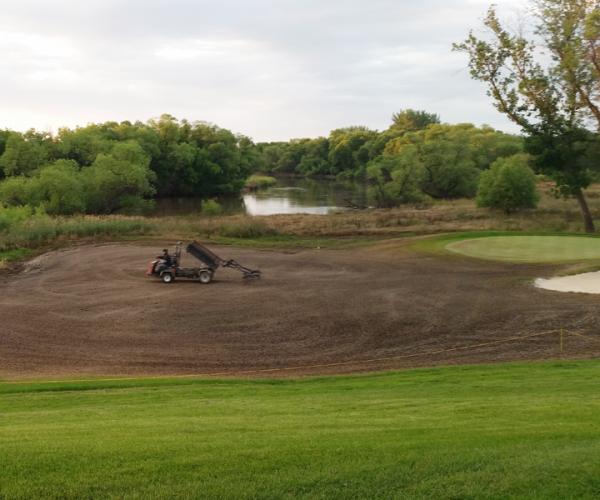 There are times when Aaron Porter maybe wishes the members of his grounds crew at Fargo Country Club weren't quite so efficient.
There are times when Aaron Porter maybe wishes the members of his grounds crew at Fargo Country Club weren't quite so efficient.With nine of 27 holes on the 100-year-old Willie Watson design in North Dakota prone to flooding from the Red River, Porter's crew of 18 has become very good at flood recovery work. That's a good thing, because in the six years that Porter has been superintendent at Fargo, the north-flowing river has overrun its banks onto the golf course 16 times, including this year. Nine of those floods, including this year's, are what the 40-year-old Porter calls "killers" in that they wipe out just about everything in their path.
Each time the floodwaters recede, Porter and his staff routinely have the course cleaned of silt, reseeded and ready for play in about a month. Such efficiency has made it difficult to sell members on a pricey flood-mitigation plan drafted by professional golfer and course architect Tom Lehman that would bring all of the holes out of harm's way.
"If I had a bad crew, maybe I could've gotten (the flood-mitigation plan) through by now, but we're so good at establishing ryegrass in this valley that I'm able to whip something together," Porter said.
As good as Porter and his crew are, the arduous task of recovery can take it's toll.
"All this sweat for what? So you can play golf on it for two weeks?" he said. "Because that's all we've had so far this year."
The Red River once was marked with acres of wetlands that held water and made flooding truly a 100-year event. But as more of that land is converted to agriculture use, flooding has become an annual occurrence during the past 15 years.
"We are a by-product of modern agriculture," said Porter, a finalist for TurfNet's 2009 Superintendent of the Year award. "The Red River Valley used to be part of the Prairie Pothole Region with slews and ditches. They've all been drained.
"All the water from those farm fields shears off the fields and right into the river. Now, after a 3-inch rain the river jumps 5 feet. It used to be 3 inches of rain never moved the river."
Most of the course has remained unchanged since Watson signed off on the design in 1914. Nostalgia, as much as anything, is to blame for the club's more established members not falling into line with Lehman's plan.
"The holes located down in the floodplain are beautiful, when they're not flooded. The other holes are as good as you will find anywhere," Porter said.
"Instead of this course being a 100-year-old classic, we flood. The holes that don't flood are great, but it's the holes that flood that take precedence. They are what we are known for."
Throughout the course, Fargo has bentgrass tees and Poa greens. The fairways that remain dry are a mix of old bluegrasses that have stood up to the test of time.
Although several holes are prone to flooding, Nos. 14-18 get the worst of it during summer. And each time, fairways are cleaned of silt then prepped and seeded with perennial ryegrass, for its quick establishment, at rates that Porter calls "ridiculous." Porter uses a three-way blend of Barenbrug's Regenerative Perennial Ryegrasses for quick establishment as well as for their regenerative properties.
 Prep work includes running a spiker in multiple directions over the fairways, disrupting the top inch or so of the soil until it produces a smooth seedbed. The site is aerified and a spreader broadcasts seed at rates up to 15 pounds per 1,000 square feet, or as much as five times the normal rate, Porter said. A drum roller helps maximize seed-soil contact before fertilizer and water are applied to help the process along. Each time, the fairways are ready for mowing after about a week.
Prep work includes running a spiker in multiple directions over the fairways, disrupting the top inch or so of the soil until it produces a smooth seedbed. The site is aerified and a spreader broadcasts seed at rates up to 15 pounds per 1,000 square feet, or as much as five times the normal rate, Porter said. A drum roller helps maximize seed-soil contact before fertilizer and water are applied to help the process along. Each time, the fairways are ready for mowing after about a week.So far this year, Porter says he's used 8,000 pounds of ryegrass seed and at least 72,000 pounds since he started at Fargo.
"It's grass on steroids," Porter said. "It's unconventional. If I had time, I'd seed at 2 to 3 pounds per 1,000, but I don't have time. We just blow it in."
A graduate of Iowa State University, Porter was the North Course superintendent at Des Moines Golf and Country Club in Iowa before taking the job at Fargo. One of his former bosses at Des Moines says Fargo's members made the right choice for such a daunting and recurrent task as flood recovery when they hired Porter in 2008.
"He has always been a hard charger. He goes 100 percent in one direction," said Rick Tegtmeier, CGCS at Des Moines. "He's not afraid to make a mistake and he doesn't worry about consequences because he is so confident in his abilities."
Porter had no experience dealing with flooding when he accepted the job at Fargo in 2008. He's had plenty since, and he says he's learned from the best in assistants Bill Broeckmeier and Dave Lorentz, who have more than 40 years combined experience at Fargo.
"They are rock stars," Porter said. "We've gotten so good, that a month after a flood, our members have forgotten about it."
Although most of the damage is to fairways, some greens have been damaged through the years, as well, and that is becoming a problem. In five years, Porter has exhausted his nursery and has had to take from other areas of the course for sod.
"I've been robbing from everywhere I can rob grass," he said. "We've cut up a chipping green. Now, we're regrowing the practice green to use it for sod. We rob low parts of the fairways and strip the backs of tees that are not highly used."
With so much devastation year after year, Porter says it's a challenge to keep himself and his staff motivated.
"It's hard not to show your emotions and to keep motivated," he said. "But, I have a job to do, and I love what I do. There is nothing else I'd rather be doing besides working on a golf course, except doing it where we're not constantly recovering from flooding."

